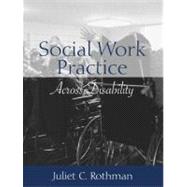
Chapters begin with “Introduction” and end with “Chapter Summary” and “Questions for Thought and Discussion.”
INTRODUCTION.
I. THE SOCIETAL FRAMEWORK.
1. Theoretical Frameworks.
Individual Models.
Societal Models.
The Development of Norms.
A Feminist Model of Disability.
Stigmas and Other Marks.
2. An Historical Perspective.
The Colonial Period and Early Nationhood.
The Nineteenth Century.
Early Twentieth Century.
Late Twentieth Century.
3. The Disability Rights Movement in the Unites States.
Early Efforts.
The First Advocacy Organization.
Precipitating Influences.
Ed Roberts and the CIL's.
Organizing Demonstrations and the Rehabilitation Act of 1973.
Wade Blank and ADAPT.
Other Disability Rights Organizations.
The Universal Design Movement.
4. Disability Legislation and the ADA.
Federal Laws.
State Laws.
Case Law.
Additional Information on Disability Laws.
5. Disability Demographics.
Sources of Demographical Information.
Americans with Disabilities: 1997.
Prevalence of Disability by Age, Sex, Race, and Hispanic Origin.
Employment and Income, as Related to Disability Status.
Census Bureau Data: March 2001.
Healthy People 2010 Baseline Data.
II. THE INDIVIDUAL FRAMEWORK.
6. Disability and Identity Development.
Facets of Our Identity.
Adaptation.
Mackelprang and Salsgiver's Life Stage Development Concept.
Disability Identity as a Learned Social Role.
Empowering and Normalizing Disability Identity.
Rolland's Three Categories of Disability Identity.
Avoidance of Disability Identity.
Disability and the Minority Experience.
7. Disability Groupings Systems.
National Health Interview Survey: Grouping by Activity Limitation.
Disability Statistics Center: Grouping by Causative Condition.
Access Unlimited: Grouping by Impairment in Learning and Working.
Disability Classifications "Commonly Used" by Schools.
U.S. Department of Education: Grouping by Frequency of Occurrence.
Disability Classifications for Sports Participation in Special Events.
Rolland's Disability Categories: A Typology of Disability.
Disability Categories and the Medical Model.
8. Understanding the Disability Experience.
Part I: Onset, Course, and Outcome.
9. Understanding the Disability Experience.
Part II: Experiencing Limitation and Stereotypes.
III. SKILLS FOR SOCIAL WORK PRACTICE.
10. Using Client Strengths and Worker Skills to Optimize Communication.
Communicating Across Sensory Impairment.
Communicating Across Speech Impairment.
Communicating Across Mental Illness.
Communicating Across Developmental Disability.
Communicating Across Cognitive Differences.
Communicating Across Physical Immobility.
11. Trust and Relationship Building.
Trust Building and Belief-Bonding.
Empathy and Sympathy.
Self-Monitoring and the Assumptions Trap.
Developing Patience and Understanding.
Reducing Fear and Discomfort.
12. Assessing Individuals and Communities.
The Ecological Framework.
The Strengths Perspective.
The Biopsychosocial Perspective.
A Disability-Specific Framework for Assessment.
Addressing Quality of Life Issues.
The Community Needs Assessment.
13. Practice Models: Working with Individuals.
The Crisis Intervention Model.
The Empowerment Model.
The Advocacy Model.
The Case Management Model.
The Social Construct Model, Revisited.
14. Practice Models: Working Within the Disability Community.
The Community Needs Assessment Model.
The Self-Help Group Model.
The Empowerment Model.
The Social Action/Functional Community Model.
15. Practice Models: Disability as a Social and Political Concern.
The Coalition-Building Model.
Haynes and Mickelson's Political Advocacy Models.
The Social Movement Model.
IV. THE DISABILITY RESOURCE AND SUPPORT NETWORK.
16. Overview of Network and Services in the Public Sector.
Federal Government Resources.
State Government Resources.
Local Government Resources.
17. Overview of Network and Services in the Private Sector.
Disability-Specific Organizations.
Cross-Disability Service Organizations.
Location-Based Disability Services.
18. Public/Private Intersections in Healthcare.
Medical Care.
Home and Community-Based Care.
Nursing Home Care.
Ancillary Health Care Services.
19. Public/Private Intersections in Housing and Personal Care Needs.
Community Living.
Communal Living.
Residential Care.
Personal Care Attendants.
Homeless Disabled People.
20. Public/Private Intersections in Income Support and Employment.
Employment.
Education, Training, and Rehabilitation.
Income Support.
21. The Social Support and Recreational Network.
The Social Support Network.
Caregiver and Family Support.
Leisure and Recreation Activities.
22. Mobility, Access, and Assistive Technology.
Mobility in the Built Environment.
Adaptable Living Space.
Assistive Technology.
Appendix.
The New copy of this book will include any supplemental materials advertised. Please check the title of the book to determine if it should include any access cards, study guides, lab manuals, CDs, etc.
The Used, Rental and eBook copies of this book are not guaranteed to include any supplemental materials. Typically, only the book itself is included. This is true even if the title states it includes any access cards, study guides, lab manuals, CDs, etc.